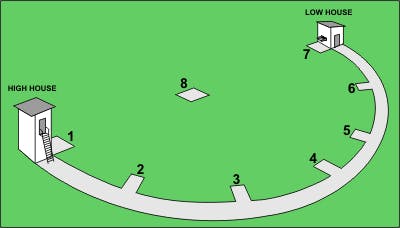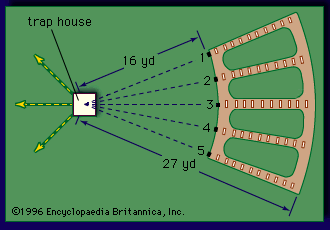No better way to spend your time than breaking a few clays with some of your friends. Check the club calendar for the next open day.
Here at WEGC we offer both trap and skeet. Nothing is better than seeing that clay bird burst with a solid hit! We also have a patterning board at the shotgun range. This allows you to test chokes and see just where you are hitting. Come out and shoot with us. If you need help with the game of trap and skeet, we have friendly people who will help you. You don’t have to have a special shotgun,(for skeet you will need a gun that shoots doubles), just bring your favorite and a couple of boxes of shells.
For trap shooter we recommend 11/8 ounce loads. We also don’t allow shot larger than #7.5. Add to that a vest or pouch to hold your shells. Of course you will need your eye and ear protection that is required at the WEGC range.
We are open the first and third Saturday, the second and fourth Wednesday and the second and fourth Sunday of the month from 8 AM to approximately 2:00 PM.
$7 members/$8 guests per round
Our shotgun director Sonny Harris is ready to answer any questions you might have. Contact him at [email protected].

The Skeet Field
Today’s skeet field varies little from its 1920 beginnings. It has eight shooting stations and two trap houses. Seven of the stations are arranged in a half moon between the two trap houses, and one station is directly between them. The high house, on the left side of the field, throws its targets from a trap 10 feet above the ground. The target rises to a height of 15 feet by the time it travels to the center of the field. The low house target, on the right side, leaves the trap house just 3-1/2 feet from the ground. It also rises to a height of 15 feet by the time it reaches the center of the field.
A Round of Skeet
A round of skeet consists of 25 targets, with 17 shot as singles and 8 as doubles. The first miss is repeated immediately and is called an option. If no targets are missed during the round, the last or 25th target is shot at the last station, low house 8. The shooting sequence is as follows:
Stations 1 and 2: High house single; Low house single; High house/Low house pair
Stations 3, 4, and 5: High house single; Low house single
Stations 6 and 7: High house single; Low house single; Low house/High house pair
Station 8: High house single; Low house single
Skeet is shot in squads of up to five shooters. They move from station to station around the half moon, ending up in the center, at the end of the round.
Any gauge shotgun may be used, of any type, as long as it can fire at least two shots. The preferred shot size is #9, but nothing larger than 7-1/2 should ever be used. Since strength is not a factor, women are able to compete equally with men. Left handed shooters do just as well as right.

Trapshooting is a specific form of clay target shooting. Trapshooting is a game of movement, action and split-second timing. It requires the accuracy and skill to repeatedly aim, fire and break the 4 1/4 inch disc which are hurled through the air at a speed of 42mph, simulating the flight path of a bird fleeing a hunter.
Trapshooting’s continual growth and expanding popularity is due to the fact that people of all ages, incomes and abilities can compete. Nine year old boys shoot alongside 90 year old men. Many 70-year olds have been in the sport 55 years and some began just two years ago. Trapshooting’s participants include millionaires and hourly wage earners, inventors and businessmen, former sports figures in other fields, professional men, farmers, truck drivers, musicians, actors, students and housewives.
The shooter is required to shoot at a target after he calls “pull.” It does not matter in scoring if the shooter hits only a small piece of the target or whether he shatters the target. The target is considered a “dead” or “lost” bird. If the target is hit it is “dead.” It is the shooters responsibility to check his own score.
